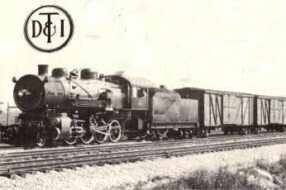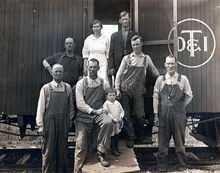The Detroit, Toledo and Ironton Railroad operated between its namesake cities
of Detroit, Michigan and Ironton, Ohio via Toledo between 1905 and 1983. At the
end of 1970 it operated 478 miles of road on 762 miles of track; that year it
carried 1244 million ton-miles of revenue freight.
Early History In 1901, the merger of the Detroit and Lima Northern Railway and the Ohio
Southern Railway formed the Detroit Southern Railroad. This company was
purchased at foreclosure on May 1, 1905 by Harry B. Hollins & Company of
New York, which reincorporated it in the state of Michigan under the name of
the Detroit, Toledo and Ironton Railway.
Samuel Hunt, president of the Detroit Southern Railroad, was to remain president
of the reorganized Detroit, Toledo and Ironton Railway. However, he died suddenly
on May 15, 1905. George Miller Cumming, a lawyer based in New York City who was
the former first vice-president of the Erie Railroad Company and the former
chairman of the board of the Cincinnati, Hamilton and Dayton railroad, was elected
president in June and served for one month. F. A. Durban was elected president in
July but resigned in November, at which time he was replaced by Eugene
Zimmerman. (Both Cumming and Durban continued to serve as officers under
Zimmerman's presidency.) (DT&I Steam Freight)
The line went bankrupt in 1908, but remained solvent until it was purchased
by Henry Ford in 1920. Ford recognized the strategic importance of the line to his
automobile business as the line left Dearborn, Michigan and connected with all of
the major east-west rail lines in the Midwest. This gave Ford direct control over
shipments of raw materials and finished goods to and from his factories in
Dearborn. The line thrived and saw numerous improvements under Ford's
management. However, Ford sold the line in 1929 to the Pennsylvania Railroad
after becoming disgusted with interference and over regulation from the
Interstate Commerce Commission.
(DT&I Steam Freight)
The line went bankrupt in 1908, but remained solvent until it was purchased
by Henry Ford in 1920. Ford recognized the strategic importance of the line to his
automobile business as the line left Dearborn, Michigan and connected with all of
the major east-west rail lines in the Midwest. This gave Ford direct control over
shipments of raw materials and finished goods to and from his factories in
Dearborn. The line thrived and saw numerous improvements under Ford's
management. However, Ford sold the line in 1929 to the Pennsylvania Railroad
after becoming disgusted with interference and over regulation from the
Interstate Commerce Commission.
Ann Arbor Railroad
In June 1905, the Detroit, Toledo & Ironton Railway (DT&I) took control of the
Ann Arbor Railroad (AA), which they purchased from Rudolph Kleybolte & Co. The
AA connected Toledo with Frankfort, Mich., and the acquisition essentially doubled
the DT&I system. DT&I only controlled the AA until 1908 when another bankruptcy
forced the DT&I to divest its acquisition.
In 1963, the DT&I, itself by then a subsidiary of the Pennsylvania Railroad,
once again gained control of the AA. The Ann Arbor lines would later become part
of the formation of Conrail in April 1976 but were still facing abandonment.
They were purchased by the state of Michigan in October 1977 with the intent of
preserving rail service over its tracks. Subsequently, the state divested itself
of the lines and remnants of the AA are now owned and operated by several short
line railroad companies (including one with the same name as the original).
 (Work Train, circa 1921)
The Pennsylvania years
The line operated as an independent subsidiary of the Pennsylvania Railroad
from 1929 until 1970. In 1955, the line replaced its steam locomotives with
diesel locomotives. It did however, have a short-lived operation using heavy-
electric boxcab locomotives. The catenary masts of which survived for decades
after de-electrification, as it was deemed too expensive to demolish them.
The DT&I relied exclusively on diesel locomotives built by General Motors
Electro-Motive Division. The new diesel locomotives were painted bright orange
throughout this period, though the specific design and placement of the
railroad's logo varied with time.
(Work Train, circa 1921)
The Pennsylvania years
The line operated as an independent subsidiary of the Pennsylvania Railroad
from 1929 until 1970. In 1955, the line replaced its steam locomotives with
diesel locomotives. It did however, have a short-lived operation using heavy-
electric boxcab locomotives. The catenary masts of which survived for decades
after de-electrification, as it was deemed too expensive to demolish them.
The DT&I relied exclusively on diesel locomotives built by General Motors
Electro-Motive Division. The new diesel locomotives were painted bright orange
throughout this period, though the specific design and placement of the
railroad's logo varied with time.
The Later Years
In 1968, the DT&I's parent company, the Pennsylvania Railroad, merged with
its longtime rival, the New York Central Railroad, to become the Penn Central,
which declared bankruptcy two years later and sold off the DT&I to private
investors. In 1980, the DT&I was acquired by the Grand Trunk Western Railroad
(GTW). Under the GTW, the DT&I locomotives were painted in the red and blue
livery of the GTW, but retained the DT&I logo. In December 1983, the DT&I was
completely assimilated into the GTW.
End of Service on Southern Portion
In April 1982 a collapse in Royersville Tunnel (the only tunnel on the old DT&I)
prompted GTW to shut down the line between Jackson and Ironton. The tunnel had
suffered collapses many times in the past but limited remaining business south
of Jackson and the operational problems of the tunnel led to GTW's decision.
At the same time, GTW bypassed the steep and treacherous Summithill section
between Bainbridge and Waverly by rerouting trains onto Chessie System trackage
from Washington Court House, Ohio to Waverly, then back onto the former DT&I to
Jackson. In 1984 all operations south of Washington Court House were suspended,
the Jackson Shops closed, and the track dismantled.
|


